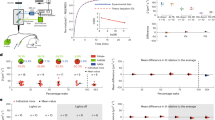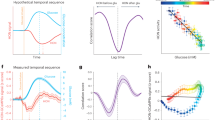Abstract
Most of the experimental evidence for a role of arginine-vasopressin (AVP) in adrenocorticotropic hormone (ACTH) release comes from in vitro studies1. The multimolecular nature of the hypothalamic factor responsible for corticotropin (CRF) release has long been recognized2, but the importance of AVP as a cofactor is controversial3,4. The recently characterized 41-residue peptide5,6 fulfills the criteria for a physiological role in ACTH release7–9 and it is potentiated in vitro by AVP10,11. In vivo, AVP is able to stimulate ACTH secretion12, and Brattleboro rats, deficient in AVP, show a reduced activity of the hypothalamo-hypophysial-adrenocortical system (HHCS) (see ref. 13 for references). Direct evidence for involvement of AVP in the physiological release of ACTH is, however, still lacking. The recent development of AVP receptor antagonists14 provides the opportunity to test this hypothesis directly. I report here that pretreatment by 1-deaminopenicillamine, 2-(O-methyl)tyrosine arginine-vasopressin (dPTyr(Me)AVP), a potent antagonist of the vasopressor14,15, behavioural15 and ACTH-releasing properties of AVP16, does not modify the ACTH and corticosterone secretion induced by exposure to a novel environment, but totally inhibits the increase of ACTH and corticosterone levels induced by AVP. The results do not support the hypothesis for a physiological involvement of AVP in ACTH release.
This is a preview of subscription content, access via your institution
Access options
Subscribe to this journal
Receive 51 print issues and online access
$199.00 per year
only $3.90 per issue
Buy this article
- Purchase on Springer Link
- Instant access to full article PDF
Prices may be subject to local taxes which are calculated during checkout
Similar content being viewed by others
References
Baertschi, A. J. & Bény, J.-L. Frontiers Horm. Res. 10, 126–140 (1982).
Pearlmutter, A. F., Rapino, E. & Saffran, M. Endocrinology 97, 1336–1338 (1975).
Gillies, G. & Lowry, P. Nature 278, 463–464 (1979).
Pearlmutter, A. F., Dokas, L., Kong, A., Miller, R. & Saffran, M. Nature 283, 697–698 (1980).
Vale, W., Spiess, J., Rivier, C. & Rivier, J. Science 213, 1394–1397 (1981).
Spiess, J., Rivier, J., Rivier, C. & Vale, W. Proc. natn. Acad. Sci. U.S.A. 78, 6517–6521 (1981).
Rivier, C., Brownstein, M., Spiess, J., Rivier, J. & Vale, W. Endocrinology 110, 272–278 (1982).
Sueiras-Diaz, J. et al. Life Sci. 31, 429–435 (1982).
Hook, V. Y. H., Heisler, S., Sabol, S. L. & Axelrod, J. Biochem. biophys. Res. Commun. 106, 1364–1371 (1982).
Gillies, G. E., Linton, E. A. & Lowry, P. J. Nature 299, 355–357 (1982).
Turkelson, C. M. et al. Peptides 1, 111–113 (1982).
Yasuda, N., Greer, M. A., Greer, S. E. & Panton, P. Endocrinology 103, 906–911 (1978).
Conte-Devolx, B. et al. Endocrinology 110, 2097–2100 (1982).
Bankowski, K., Manning, M., Haldar, J. & Sawyer, W. H. J. med. Chem. 21, 850–853 (1978).
Le Moal, M. et al. Nature 291, 491–493 (1981).
Aizawa, T., Yasuda, N., Greer, M. A. & Sawyer, W. H. Endocrinology 110, 98–104 (1982).
Mason, J. W. J. psychiat. Res. 8, 323–333 (1971).
Murphy, B. E. P. J. clin. Endocr. Metab. 27, 973–990 (1967).
Britton, D. R., Koob, G. F., Rivier, J. & Vale, W. Life Sci. 31, 363–367 (1982).
Wood, C. E., Shinsako, J., Keil, L. C., Ramsay, D. J. & Dallman, M. F. Endocrinology 110, 1416–1421 (1982).
Koob, G. F. et al. Regulat. Peptides 2, 153–163 (1981).
Kasting, N. W., Veale, W. L. & Cooper, K. E. Neurosci. Biobehav. Rev. 6, 215–222 (1982).
Husain, M. K., Manger, W. M., Rock, T. W., Weiss, R. J. & Frantz, A.-G. Endocrinology 104, 641–644 (1979).
Author information
Authors and Affiliations
Rights and permissions
About this article
Cite this article
Mormède, P. The vasopressin receptor antagonist dPTyr(Me)AVP does not prevent stress-induced ACTH and corticosterone release. Nature 302, 345–346 (1983). https://doi.org/10.1038/302345a0
Received:
Accepted:
Issue Date:
DOI: https://doi.org/10.1038/302345a0
This article is cited by
-
Genetic analysis of the relationships between behavioral and neuroendocrine traits in roman high and low avoidance rat lines
Behavior Genetics (1995)
-
The phenomenon of stress: Concepts and mechanisms associated with stress-induced responses of the neuroendocrine system
Veterinary Research Communications (1987)
-
Specificity of aversive stimulus properties of vasopressin
Psychopharmacology (1985)
-
No role of vasopressin in stress-induced ACTH secretion?
Nature (1984)
-
No role of vasopressin in stress-induced ACTH secretion?
Nature (1984)
Comments
By submitting a comment you agree to abide by our Terms and Community Guidelines. If you find something abusive or that does not comply with our terms or guidelines please flag it as inappropriate.



